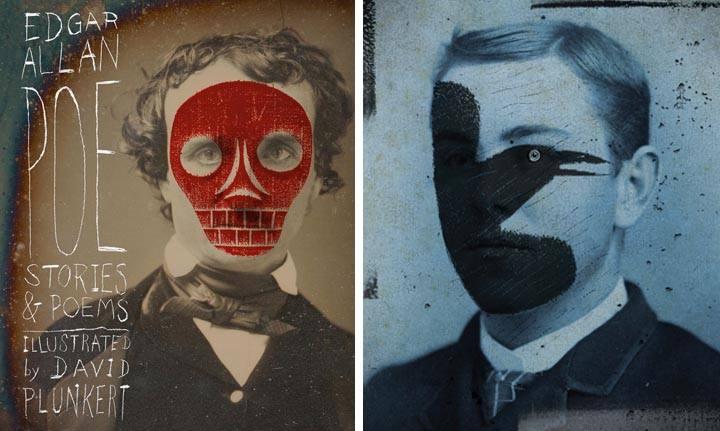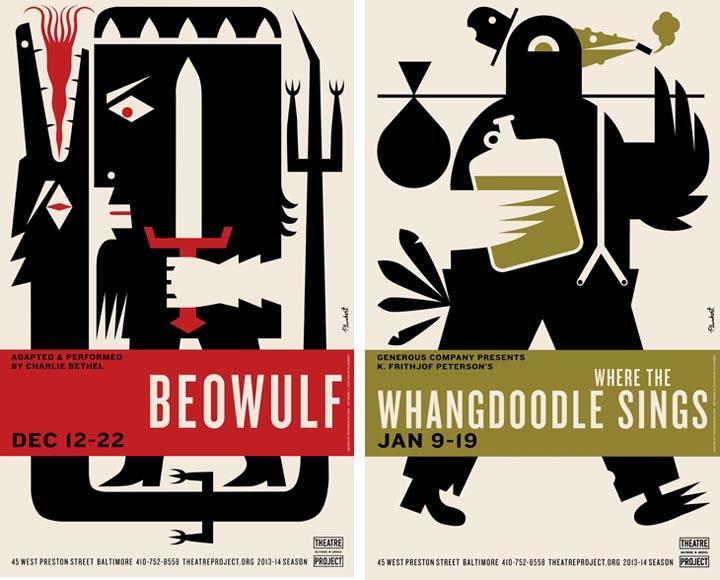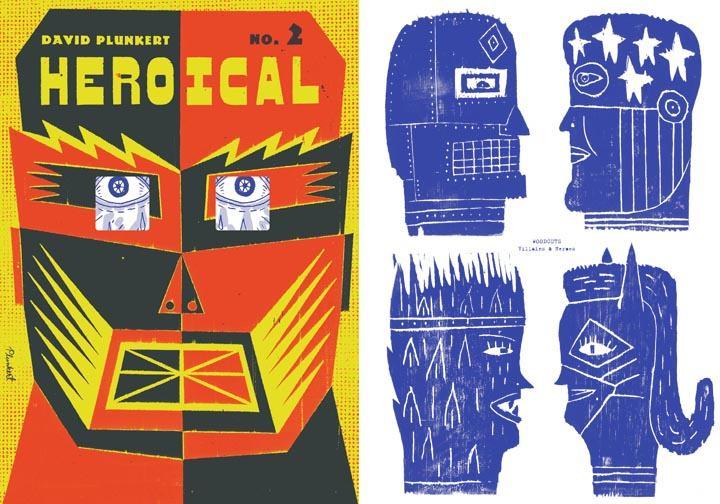The Q&A: Dave Plunkert
Q: What are some of your favorite things about living and working in Baltimore?
A: I'm originally from the Frederick area of Maryland and moved to Baltimore in 1987. Baltimore on a whole is an unpretentious town that is perfectly located between DC and Philadelphia and close to New York. The neighborhood we're in is clustered with craftspeople and artists; there's a blacksmith up the block and a letterpress printer next door.
Q: Do you keep a sketchbook? What is the balance between the art you create on paper versus in the computer?
A: I don't keep a proper sketchbook. When the drawing mood hits I sketch on any piece of paper or notebook at hand. I generally prefer to draw on individual sheets or pads as opposed to a book anyway. The primary concept or idea and the primary visual form is always in the rough pencil sketch. The computer is used for color and defining and refining the rough sketch into a final.
 Left: Cover for Edgar Allan Poe: Stories & Poems; right: interior illustration
for The Raven.
Left: Cover for Edgar Allan Poe: Stories & Poems; right: interior illustration
for The Raven.
Q: What do you like best about your workspace?
A: It's big, it's concrete, and it's zoned for light industry. This allows for many possibilities in regards to projects. It's an easy space that allows for the production of large paintings and sculptures. We've had over 500 people in here during gallery events. We could be manufacturing chairs or beer if we wanted to.
Q: Do you think it needs improvement, if so, what would you change?
A: It could use some further organization especially in the wood and metal shop area. I can cut steel but I'd like to be able to weld it too.
Q: What is the most important item in your studio?
A: It might be stretching it to call my collage morgue an "item" but I'm going to go with that. I can take a book or picture home but that doesn't compete with being able to just dig through the whole bin from time to time and possibly discover some new picture or piece of ephemera.
 Dave Plunkert’s collage morgue; photo
courtesy the artist.
Dave Plunkert’s collage morgue; photo
courtesy the artist.
Q: What is your favorite part of the creative process?
A: Definitely the thumbnail stage when the idea results.
Q: What was the strangest or most unusual assignment you’ve taken? What did you learn from the experience?
A: We recently completed the design and installation of an interactive room at the Baltimore Museum of Art called Extra-Ordinary Objects. I learned you cannot anticipate 100% how an audience will interact and behave with a given object or suggested task.
Q: What was your favorite book as a child?
A: As a kid I was great devourer of comic books. As a little kid I loved all of the Dr. Suess books.
 Left: Poster for Theatre Project
Baltimore performances of Beowulf, and right: Where the Wangdoodle Sings.
Left: Poster for Theatre Project
Baltimore performances of Beowulf, and right: Where the Wangdoodle Sings.
Q: If you had to choose one medium to work in for an entire year, eliminating all others, what medium would you choose?
A: Pen and ink.
Q: What are some of your favorite places/books/blogs/websites for inspiration?
A: I love looking through old magazines and digging through old stacks of paper. I thumb through artist monographs very frequently. Some recent artist's book I've been looking at include The Obsessive Images of Seymour Chwast; Posada: A Century of Skeletons; and Deep Blues: Bill Traylor, to name a few.
Q: What was the painting or drawing or film that most affected your approach to art [the Tunderbolt]?
A: Easy! I saw Westworld in theatres in 1973 when I was eight.
Q: If you could be anywhere but where you are now, where would that be?
A: On a 25 degree December day the answer would be any warm beach.
Q: Where do you teach—and what do you like best about teaching?
A: I'm on the roster at MICA though I'm not currently teaching a class. I prefer teaching poster design or concepts. What I like best is getting blown away by students' work; it's a good wake up call that you have to keep honing your skills as best you can.
 Left: Cover
for Heroical #2; right: interior page of woodcuts for Heroes & Villains.
Left: Cover
for Heroical #2; right: interior page of woodcuts for Heroes & Villains.
Q: Where did your idea for Edgar Allan Poe: Poems and Stories originate? What was the most difficult part about getting from idea to finished art?
A: The most difficult part of illustrating this book was creating pictures with mood and intense melancholia for the length of a book. Poe is a writer of emotion and pathos first. Sometimes there is very little action, so mood and atmosphere become very important visual components.
Q: What advice would you give a young artist about applying to an art school or college?
A: A student should have the confidence that they can be a working, full-time artist and not plan to treat it like a hobby that put you $80,000 in debt.
Q: What would be your last supper?
A: Lobster, steak and baked potato. I love vegetables too but why bother with them at your last meal?
 Left: Poster
for Sawkill Lumber Company; right: a poster for MICA's National Portfolio Day
Left: Poster
for Sawkill Lumber Company; right: a poster for MICA's National Portfolio Day
David Plunkert's illustrations have appeared in advertising campaigns for Fortune 500 companies as well as major newspapers, magazines, and recording labels. His work has been recognized by American Illustration, Communication Arts, Graphis, Print, the Society of Illustrators, and The New York Art Directors’ Club. He has been featured in numerous books including: Cool Type, New Masters of Poster Design, The Greatest Rock Albums that Never Were, and Mixing Messages.
Plunkert has taught graphic design and illustration at Shepherd College and Maryland Institute College of Art in addition to lecturing for AIGA Chapters throughout the US. His work has been collected by museums and private collectors, and has been exhibited internationally. He has gold medals from the Society of Illustrators NY.
He and Joyce Hesselberth co-founded Spur Design in 1995. He is the creator of Heroical, an ongoing superhero anthology first published in 2013. In 2015 he illustrated and designed Edgar Allan Poe: Stories and Poems, published by Rockport. twitter: @plunkert


